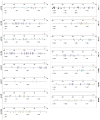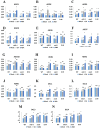Effects of Abscisic Acid and Salicylic Acid on Gene Expression in the Antiviral RNA Silencing Pathway in Arabidopsis
- PMID: 31126102
- PMCID: PMC6566719
- DOI: 10.3390/ijms20102538
Effects of Abscisic Acid and Salicylic Acid on Gene Expression in the Antiviral RNA Silencing Pathway in Arabidopsis
Abstract
The RNA silencing pathways modulate responses to certain stresses, and can be partially tuned by several hormones such as salicylic acid (SA) and abscisic acid (ABA). Although SA and ABA are often antagonistic and often modulate different stress responses, they have similar effects on virus resistance, which are partially achieved through the antiviral RNA silencing pathway. Whether they play similar roles in regulating the RNA silencing pathway is unclear. By employing coexpression and promoter analyses, we found that some ABA- and SA-related transcription factors (TFs) are coexpressed with several AGO, DCL, and RDR genes, and have multiple binding sites for the identified TFs in the queried promoters. ABA and SA are antagonistic with respect to the expression of AGO1 and RDRs because ABA was able to induce these genes only in the SA mutant. Nevertheless, both hormones showed similarities in the regulation of other genes, for example, the induction of AGO2 by ABA was SA-dependent, indicating that ABA acts upstream of SA in this regulation. We inferred that the similar effects of ABA and SA on some genes resulted in the redundancy of their roles in resistance to bamboo mosaic virus, but that the two hormones are antagonistic with respect to other genes unrelated to their biosynthesis pathways.
Keywords: RNA silencing pathway; abscisic acid; bamboo mosaic virus; crosstalk; salicylic acid.
Conflict of interest statement
The authors declare no conflicts of interest.
Figures



Similar articles
-
Abscisic Acid Induces Resistance against Bamboo Mosaic Virus through Argonaute2 and 3.Plant Physiol. 2017 May;174(1):339-355. doi: 10.1104/pp.16.00015. Epub 2017 Mar 7. Plant Physiol. 2017. PMID: 28270624 Free PMC article.
-
The abscisic acid pathway has multifaceted effects on the accumulation of Bamboo mosaic virus.Mol Plant Microbe Interact. 2014 Feb;27(2):177-89. doi: 10.1094/MPMI-08-13-0216-R. Mol Plant Microbe Interact. 2014. PMID: 24224533
-
Voltage-dependent anion channel 3 (VDAC3) mediates P. syringae induced ABA-SA signaling crosstalk in Arabidopsis thaliana.Plant Physiol Biochem. 2024 Jan;206:108237. doi: 10.1016/j.plaphy.2023.108237. Epub 2023 Dec 12. Plant Physiol Biochem. 2024. PMID: 38109831
-
Interplay between ABA signaling and RNA silencing in plant viral resistance.Curr Opin Virol. 2020 Jun;42:1-7. doi: 10.1016/j.coviro.2020.02.002. Epub 2020 Mar 26. Curr Opin Virol. 2020. PMID: 32222536 Review.
-
Signaling Crosstalk between Salicylic Acid and Ethylene/Jasmonate in Plant Defense: Do We Understand What They Are Whispering?Int J Mol Sci. 2019 Feb 4;20(3):671. doi: 10.3390/ijms20030671. Int J Mol Sci. 2019. PMID: 30720746 Free PMC article. Review.
Cited by
-
Crop antiviral defense: Past and future perspective.Sci China Life Sci. 2024 Dec;67(12):2617-2634. doi: 10.1007/s11427-024-2680-3. Epub 2024 Aug 15. Sci China Life Sci. 2024. PMID: 39190125 Review.
-
A fungal protease named AsES triggers antiviral immune responses and effectively restricts virus infection in arabidopsis and Nicotiana benthamiana plants.Ann Bot. 2022 Apr 13;129(5):593-606. doi: 10.1093/aob/mcac013. Ann Bot. 2022. PMID: 35134835 Free PMC article.
-
Enhanced Flavonoid Accumulation Reduces Combined Salt and Heat Stress Through Regulation of Transcriptional and Hormonal Mechanisms.Front Plant Sci. 2021 Dec 21;12:796956. doi: 10.3389/fpls.2021.796956. eCollection 2021. Front Plant Sci. 2021. PMID: 34992623 Free PMC article.
-
Photosynthesis-related genes induce resistance against soybean mosaic virus: Evidence for involvement of the RNA silencing pathway.Mol Plant Pathol. 2022 Apr;23(4):543-560. doi: 10.1111/mpp.13177. Epub 2021 Dec 28. Mol Plant Pathol. 2022. PMID: 34962034 Free PMC article.
-
Transcriptome Profiling Reveals a Petunia Transcription Factor, PhCOL4, Contributing to Antiviral RNA Silencing.Front Plant Sci. 2022 Apr 14;13:876428. doi: 10.3389/fpls.2022.876428. eCollection 2022. Front Plant Sci. 2022. PMID: 35498675 Free PMC article.
References
-
- Yasuda M., Ishikawa A., Jikumaru Y., Seki M., Umezawa T., Asami T., Maruyama-Nakashita A., Kudo T., Shinozaki K., Yoshida S., Nakashita H. Antagonistic interaction between systemic acquired resistance and the abscisic acid-mediated abiotic stress response in Arabidopsis. Plant Cell. 2008;20:1678–1692. doi: 10.1105/tpc.107.054296. - DOI - PMC - PubMed
MeSH terms
Substances
Supplementary concepts
Grants and funding
- 2017H1D3A1A01054585/Korea Research Fellowship program funded by the Ministry of Science and ICT through the National Research Foundation of Korea
- 710001-3/Vegetable Breeding Research Center through the Agriculture, the Food and Rural Affairs Research Center Support Program from the Ministry of Agriculture, Food and Rural Affairs, Republic of Korea.
LinkOut - more resources
Full Text Sources

